#Pharaoh Narmer
Explore tagged Tumblr posts
Text
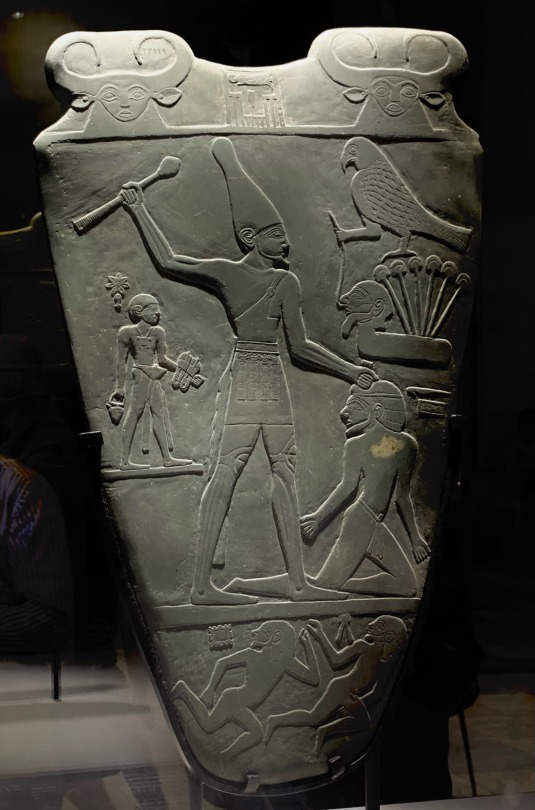
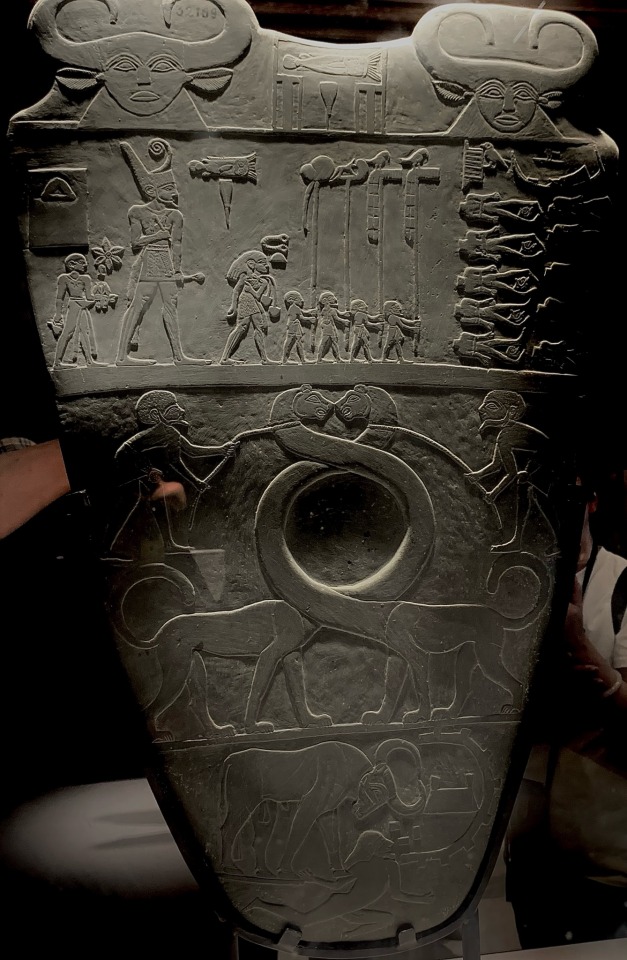
The Narmer Pallette, about 3000BC
Narmer seems to have been the first king of a unified Egypt, and this pallette likely celebrates his victories in battle. Despite its having been created right at the start of the dynastic period, it already shows lots of artistic motifs that would become canon throughout Egyptian civilization, including the form of the human body that shows the face and much of the body in profile, but the shoulders face on. The musculature of the legs and knees are also a point of focus, something that is common in Old Kingdom art. We can also see the goddess Bat, with a human face and cow ears and horns; she was a cow goddess associated with stars and the sky, whose identity (and iconography) later merged with Hathor's. Horus is also present.
On the other side of the pallette, two fantastically long-necked lions, held in check by their captors, demonstrate a symmetry that suggests they are an early precursor to later 'unification' scenes that show two gods facing one another (usually Horus and Seth or Horus and Thoth) while standing over the symbol for unification.
24 notes
·
View notes
Photo

The kings of the First Dynasty of Egypt (c. 3150 - c. 2890 BCE) all worked toward the same ends: increasing trade, expansion of the kingdom through military campaigns, engaging in building projects (such as monuments, tombs, and temples), and securing central rule of the country. They ruled from the city of Thinis, near Abydos, and from Memphis. The first king, according to Manetho's chronology, was Menes who has come to be identified with the pharaoh once thought to be his successor, Narmer. Narmer united the regions of Upper Egypt and Lower Egypt under central rule initially at Thinis before then building a palace at Memphis and shifting the seat of government to that city. Historian Margaret Bunson writes: The 1st Dynasty, begun at Memphis by Menes, was marked by significant cultural achievements. He cemented his claims to the throne and by instituting, or reinforcing, the previous modes of governmental and religious traditions that would become unique aspects of Egypt's heritage. Papyrus, writing, and a calendar were in use, and linear measurements, mathematics, and astronomy were practiced. A census, tax assessments, the reestablishment of boundaries after the yearly Nile inundations, and the development of new astronomical instruments moved the nation to new heights (77). Narmer's queen, Neithhotep, may have been the first female ruler in Egypt after his death. The kings who followed Narmer all continued his policies. The greatest of these was Den (c. 2990 BCE) who is the first monarch depicted wearing the crown of Upper and Lower Egypt, indicating his dominance over the whole region. Den's mother was Merneith who may have ruled as regent when he was young or may have reigned over Egypt as Neithhotep possibly did earlier. Military campaigns were launched against Nubia, Libya, and Sinai during the First Dynasty which resulted in greater wealth and expanded territory for Egypt and those borderlands not firmly defended were annexed. The kings of the First Dynasty were, for the most part, very effective rulers. Only Anedjib and Semerkhet are recorded as having troubled reigns. Under the rule of the pharaohs, Egypt grew from a largely agrarian culture to an increasingly urbanized state. The Egyptians seem to have been careful, however, to avoid the pitfalls of urbanization which characterized Mesopotamian cities such as overpopulation and overuse of land and water resources. The following list of First Dynasty kings is based on Manetho's chronology, the Turin King List, and archaeological evidence as given in the scholarly work Ancient Egypt: Foundations of a Civilization by Douglas J. Brewer. The dates of the reigns are approximate. Each pharaoh built upon what had been established by their predecessor and worked to preserve the principle of ma'at (harmony) in the land. Owing to their unity of vision, and a lack of written records, it is difficult to precisely date their reigns. Exact dating is further complicated by a new model of reading ancient inscriptions (such as the Narmer Palette) symbolically rather than literally. Whereas, in the early 20th century CE, a piece like the Narmer Palette was read as history, it is now interpreted as representing cultural values of the period. While there is certainly some logic and method to this new approach, it makes precise dating nearly impossible. Narmer (also known as Menes, c. 3150 BCE) Unified Upper and Lower Egypt and established a central government at Thinis (possibly his home city though he is also associated with Hierakonpolis) which then moved to Abydos and then Memphis. He married the princess Neithhotep of Naqada to solidify his rule and ally himself with Naqada's ruling house. Religious practices were developed and large building projects were initiated. Narmer also most likely led military expeditions to put down rebellions in Lower Egypt and to expand the territories into Nubia and Canaan. After his death, it is possible that Neithhotep reigned under her own authority. If so, she would be the first female ruler of Egypt and among the first in history, pre-dating early regents such as Sammu-Ramat of Assyria. Hor-Aha (c. 3100 - 3050 BCE; Greek name: Athotis) was most likely the son of Narmer and Neithhotep (though he has been associated with Menes/Narmer himself). He continued his father's policies of military campaigns in Nubia but seems to have neglected Canaan. Archaeological evidence from his time indicates he was primarily interested in religious rites and building the type of tomb known as a Mastaba (Arabic for "bench") which was a precursor to the pyramids. The necropolis of Memphis dates to his reign. Djer (c. 3050 - 3000 BCE; Greek name: Uenephes), probably the son of Hor-Aha, concerned himself largely with building palaces and military expansion. He extended his rule through military campaigns in Nubia and Canaan and used the resources gained in his building projects. Trade and industry grew under his reign. Djet (c. 3000 - 2990 BCE; Greek name: Usaphais) was probably the son of Djer, but nothing is known of his reign. He was buried at Abydos. He was succeeded by his wife, Queen Merneith. Merneith (c. 2990 BCE) was the wife of Djet and mother of his successor Den. There is no doubt she ruled as regent when Den was still a child but may have ruled on her own and by her own authority. Manetho does not mention her in his chronology but artifacts found in her tomb at Abydos indicate she was queen of Egypt. Her influence seems to have continued into her son's reign so, even if she did not rule in her own right, she certainly exercised power over the throne. Den (c. 2990 - 2940 BCE; Greek name: Kenkenes) was the son of Djet and Merneith. He is the first king depicted wearing the crown of both Upper and Lower Egypt. He ruled Egypt for 50 years (though part of that reign could have been under Merneith) and enlarged the country through military conquests in Sinai. Temple complexes and elaborate tombs were built under his reign and trade flourished. The Cult of Apis (also known as Hapi), the intermediary bull-deity between humans and gods, was introduced during his reign. He is considered the greatest king of the First Dynasty. Anedjib (c. 2940 - 2930 BCE; Greek name: Miebidos) was possibly Den's son but most likely his son-in-law. His reign was characterized by rebellion and little else is known of him. Semerkhet (c. 2930 - 2920 BCE; Greek name: Semempses) was considered a usurper by archaeologists and scholars for many years based upon his alleged desecration of Anedjib's name on various artifacts. This theory has been discredited with the discovery of the Cairo Stone which records his legitimate reign and his tomb. He seems to have had as difficult a time as Anedjib in controlling his kingdom Qa'a (c. 2920 - 2890 BCE; Greek name: Beieneches) was the last ruler of the First Dynasty. Very little is known about his reign except that it was very prosperous and lasted between 26 and 34 years. He was a relative of Semerkhet, probably his son. Either he had no children of his own or his sons fought over the throne since, after his death, war broke out for succession between a prince named Sneferka and another named Horus Bird. Their conflict was resolved by another prince known as Hotepsekhemwy - who either defeated them or reconciled them or both - and who then went on to found the Second Dynasty.
43 notes
·
View notes
Text
This post punched me many times (or electrocuted me, possibly hit me with a chisel, unlikely but there is a small chance I was french kissed by this fish or alternatively a pharaoh, I'm confused, morbidly fascinated and suffering psychic damage)
Have you seen this post?

You probably have. It currently has over 120,000 notes, largely because of this addition.

Of course it's going to get reblogged, this kind of unsourced factoid does numbers on here. But something about it wasn't quite right.
A bit of searching turned up the origin of the "fact".


Alright, so it's someone who posted this on reddit 4 years ago and somehow ended up in the search hits. And the post confuses the electric eel (from South America) with the electric catfish (from the Nile, which the Egyptians would have known about).

Reminder: this is an electric eel (Electrophorus electricus). It is from South America. (image from Wikipedia)

And this is an electric catfish (Malapterurus electricus). It is from the Nile and would have been familiar to the ancient Egyptians. (image from Wikipedia)
And then of course people were speculating in the notes to that post about trade routes between South America and Egypt. Excellent scholarship everyone.
At this point I was ready to call it another made-up internet fact that gets reified by people repeating it. But something was still bothering me.
An ancient Egyptian slab from 3100 BC. What could that be...
Oh.

The Narmer palette. It's the goddamn Narmer palette. (image, once again, from Wikipedia)
So where is this "angry catfish"?
It's not the Egyptian name for the electric catfish.
It's... Narmer. It's Narmer himself.

Narmer's name is written as above (detail of top middle of the palette), using the catfish (n`r) and the chisel (mr), giving N'r-mr. The chisel is associated with pain, so this reads as "painful catfish", "striking catfish", or, yes, "angry catfish" or other similar variants, although some authors have suggested that it means "Beloved of [the catfish god] Nar".
So.
Where does this leave us?
It would appear that this redditor not only confused electric eels with electric catfish, but also confused a Pharaoh's name with the name of a fish. And then it got pushed to the top search hits by a crappy search engine and shared uncritically on tumblr.
In short, "the electric eel is called angry catfish" factoid actually literacy error. Angry Catfish, who ruled upper Egypt and smote his enemies, is an outlier adn should not have been counted.
Also the Arabic name for the electric catfish is raad (thunder) or raada (thunderer).
References
Afsaruddin, A., & Zahniser, A. H. M. (1997). Humanism, culture, and language in the Near East: studies in honor of Georg Krotkoff. Eisenbrauns.
Clayton, P. A. (2001). Chronicle of the Pharaohs. Thames & Hudson.
Godron, G. (1949). A propos du nom royal. Annales du Service des antiquités de l'Egypte, 49, 217-221.
Sperveslage, G., & Heagy, T. C. (2023). A tail's tale: Narmer, the catfish, and bovine symbolism. The Journal of Egyptian Archaeology, 109(1), 3-319.
48K notes
·
View notes
Text
youtube
The name of King "Mina" has become one of the most famous names in the collective memory of the Egyptian people. It is always associated with another phrase: "The Unification of the Two Lands," referring to the unification of the kingdoms of the North and the South, and thus the emergence of Egypt as a unified state and kingdom governed by a single ruler under a system that remained stable for nearly three thousand years, marking the beginning of the Dynastic Period. But how did we come to know about King "Mina"? How was the unification of the Two Lands achieved? And what are the Two Lands?
#ancientegypt#ancient#themysteryofkingmina#ancientegyptians#KingMina#theunifieroftheTwoLands#Washearealhistoricalfigure?#firstpharaoh#egyptianhistory#history#HowwastheunificationoftheTwoLandsachieved?#howdidwecometoknowaboutKingMina?#whataretheTwoLands?#ancientegyptdecumentary#documentary#historychannel#documentairefrance2#ancientegypt101#ancientegyptanimation#narmer#kingnarmer#menes#narmerpalette#pharaoh#whowasnarmer?#firstpharaohofancientegypt#ancienthistory#narmerfirstpharaoh#narmeregyptianking#narmerhistory
1 note
·
View note
Text
Ancient African Timeline: 3150 BCE The Egyptian States are Unified
Narmer, an ancient Egyptian pharaoh who reigned between 3273 and 2980 BCE during the Early Dynastic Period, is widely regarded as the unifier of Egypt and the founder of the First Dynasty. His reign marked a turning point in Egyptian history, as he is often credited with the unification of Upper and Lower Egypt, which laid the foundation for the powerful civilization that would endure for…
0 notes
Text
12 Facical Recreations Of Africa's Ancient Egyptian Pharaohs/Figures Based On Their Respective Sculptures
The 12 facial recreations of Africa’s ancient Egyptian pharaohs and figures based on their respective sculptures offer a captivating glimpse into the past. From the regal visage of Ahmose Nefertari to the serene countenance of Queen Tiye, each reconstruction brings history to life. The majestic presence of Amenhotep III and the enigmatic charm of Nefertiti are captured with remarkable precision.…
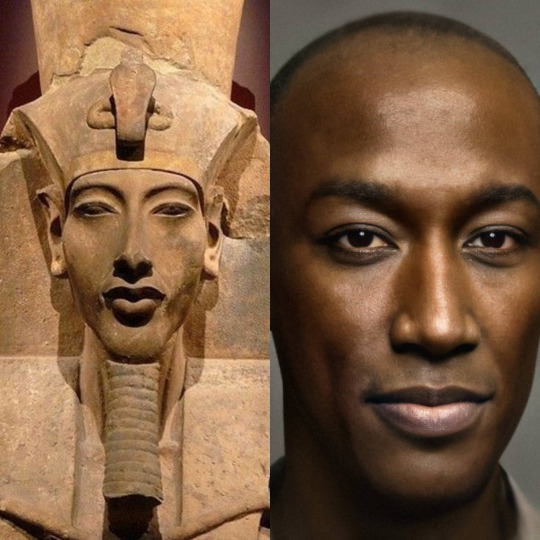
View On WordPress
#12 Ancient Egyptian Pharaohs Facical Recreations#African History#Ahmose Nefertari#Akhenaten#Amenemhat III#Amenhotep III#Ancient Egyptian Pharaohs Facical Recreations#Ancient Egyptians#ancient egyptians history#Djoser#Narmer#Nefertiti#Queen Tiye#Rameses II#Sahure#Senusret III#Tutankhamen
0 notes
Text

Weeping Gods (WIP)
This tale sweeps you up and drops you back 3500 years into the past, straight onto the banks of the Nile, at the dawn of the Egyptian New Kingdom. The Empire has only been liberated from a hundred year old occupation. The scars left by the war are still healing and yet, threats loom on the horizon again. Some powerful artifacts have been stolen and the king entrusts you with their recovery. Suddenly finding yourself out of your depth and all out of options, you have no choice but to agree to the dangerous mission. You don't know what awaits you on this journey but you know one thing for sure: if you don't catch the enemies of the empire, you will risk more than your own life.
Take your fate into your own hands, solve mysteries, meet new friends, fall in love, learn about magic, monsters, spirits, gods, and have fun in the ancient Egyptian Kingdom in this historical fantasy novel.
The story is a work of fiction and is not historically accurate.
Features
Choose from 4 different origin characters, each with unique stories and choices that will follow you through the rest of the game:
- a priest in over their head with a caring and loyal mentor
- a noble very much in over their head with a problematic family
- the captain of the Theban Guard, who is way too tired for this
- a thief from the slums of Thebes, desperate for survival
Play as male, female or non-binary; gay, straight or bi.
Build friendships, rivalries, or find love with a young prince, a mysterious spymaster, a brooding spirit, an elite warrior… or even the pharaoh himself.
Explore Egypt through a series of adventures with a ragtag team of characters
Solve mysteries, climb the Great Pyramid of Giza, deal with the sparks of revolution, and help secure the kingdom's future
Warnings: The story will contain heavy and dark themes, excessive swearing, mental health problems, and optional sexual content, so it is recommended for mature audiences only. The whole list of triggering content can be found in the beginning of the demo.
The Romances
Narmer - A kind and patient man with a golden heart, a fierce sense of duty, a bloody past, and way too little free time.
Qenna (m/f) - The living enigma. Fun and casual at first glance, but why is everyone warning you against spending time with them?
Zaia (m/f) - Spends most of their time brooding or hiding from people, but they can be surprisingly cheeky with those they feel comfortable with.
Tabiry - A dependable and loyal woman, she is the type of person you could trust to have your back in any situation.
Ahmose (m/f) - Young and impressionable, with a dazzling smile and too much hope for a better future.
The Demo
Chapters 1 - 4
Chapter 5 in progress (some choices missing)
Public demo word count : 686 000 words
Patreon demo word count: 686 000 words
Average playthrough on any origin: no idea, around 90 - 100 000 words
Last public update: 06. June 2025.
Last patreon update: 01. June 2025.
(First published: 14. Aug. 2024.)
DEMO | Patreon | FAQ | ROs and NPCs | CoG Forum | Pinterest
#interactive fiction#interactive game#interactive if#interactive novel#weeping gods#historical fantasy#historical fiction#wip#ancient egypt#choicescript#if wip#if game#choice of games#hosted games
1K notes
·
View notes
Text


Narmer Palette
Period: Late Predynastic Period
Dynasty: Dynasty 0, reign of Narmer (ca. 3000 BC)
The Narmer Palette was discovered in 1897-98 by British archeologists Quibell and Green at the city of Nekhen. It was found in the Temple of Horus and is mostly believed to have been a sacred object used for ritual.
Above: To the right is Horus as a falcon, holding the pharaoh's next victim by a rope through the nostrils.
Below: The circle formed by the entwining necks of the ‘serpopards’ on the Narmer Palette is where ingredients were ground to apply facial or body cosmetics. Above and to the right appear the pharaoh's enemies, decapitated, their heads between their feet. Below, he is represented as a bull, battering down the walls of enemy cities.
The Egyptian Museum
178 notes
·
View notes
Text
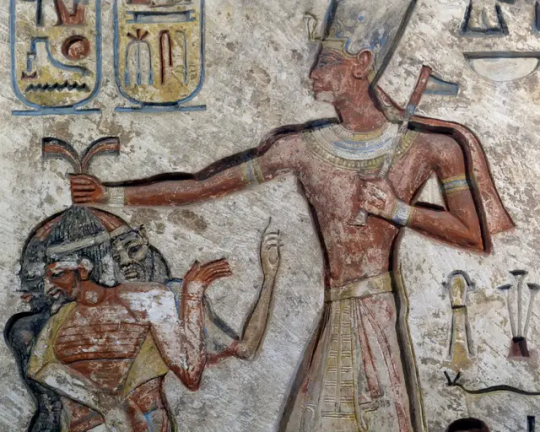
Relief of Ramesses II Smiting his Enemies
The facial features, the hairstyle and the beards of the enemies indicate that they belong to three different peoples: the Nubians, the Libyans and the Asiatics.
The theme of the pharaoh massacring enemies is an ancient one that has been known since the 1st Dynasty and can be seen for example in the Narmer Palette.
New Kingdom, 19th Dynasty, ca. 1279-1213 BC. Painted limestone. From Memphis. Now in the Egyptian Museum, Cairo. JE 46189
Read more
106 notes
·
View notes
Text
Round 3 - Mammalia - Perissodactyla




(Sources - 1, 2, 3, 4)
Perissodactyla is an order of ungulates, commonly referred to as the “odd-toed ungulates”. It is composed of three living families: Equidae (“horses”, “asses”, and “zebras”), Rhinocerotidae (“rhinoceroses”), and Tapiridae (“tapirs”).
Perissodactyls are typically defined by having reduced the 5 original ungulate toes to 3 or 1 weight-bearing toes, though tapirs retain four toes on their front feet. Equids, adapted for speed, are unique in having almost completely lost all of their toes, bearing weight on one single toe on each foot. Perissodactyls have a long upper jaw with an extended diastema (gap) between the front and cheek teeth, giving them an elongated head. They often have highly mobile lips for manipulating grass, leaves, and other plant parts. Perissodactyls are exclusively herbivores. Tapirs and equids have dense, short coats of fur, often with a mane of hair on the dorsal ridge of their neck, while rhinos have only sparse hair and thick skin. Perissodactyls inhabit a number of different habitats, leading to different lifestyles. Tapirs are solitary and live mainly in tropical rainforests in the Southern Hemisphere. African rhinos tend to live alone in dry savannas, while Asian rhinos live in wet marsh or forest areas. Equids inhabit open areas such as grasslands, steppes, or semi-deserts, and live together in groups.
Perissodactyls are characterized by a long gestation period and a small litter size, usually delivering a single calf (or “foal” in equids). Newborn perissodactyls are precocial, and are often able to stand and follow their mother after a few hours. Young are nursed for a relatively long time, often into their second year, with rhinos reaching sexual maturity around 8 or 10 years old, while equids and tapirs mature around 2 to 4 years old.
The tiny Radinskya from the Late Paleocene of East Asia is often considered to be one of the oldest close relatives of the ungulates, and was most similar to perissodactyls. Perissodactyla itself appeared at the beginning of the Lower Paleocene about 63 million years ago, both in North America and Asia, in the form of phenacodontids and hyopsodontids. The oldest known equid was Sifrhippus, from the Early Eocene. The ancestors of tapirs and rhinos, which may have included Hyrachyus, appeared not long after.

Propaganda under the cut:
The African Wild Ass (Equus africanus), ancestor of the Domestic Donkey (Equus africanus asinus), is critically endangered, with about 570 existing in the wild.
Domestic Donkeys were probably first domesticated by pastoral people in Nubia around 4000 BC, and they replaced the ox as the chief pack animal of that culture. The tomb of either King Narmer or King Hor-Aha (two of the first Egyptian pharaohs) was excavated and the skeletons of ten donkeys were found buried in a manner usually used with high ranking humans, showing that donkeys were likely very important in early Egyptian culture.
The Onager or Asiatic Wild Ass (Equus hemionus) (image 3) is one of the fastest land mammals, capable of running 64–70 km/h (40–43 mph).
The Kiang or Tibetan Wild Ass (Equus kiang) is the only wild perissodactyl to not be threatened in any way; their population is classified as “least concern.” Natural historian Chris Lavers points to travellers' tales of the Kiang as one source of inspiration for the unicorn, first described in Indika by the Ancient Greek physician Ctesias.
Asses were named before “ass” became a slang term for buttocks. In fact, the slang term was originally “arse,” a separate word from the animal “ass”, but the r was dropped in the 1860s, meaning both words have different linguistic origins.
The Domestic Horse (Equus ferus caballus) was domesticated from now extinct wild horses around 4000 BC, and their domestication is believed to have been widespread by 3000 BC. They were one of the first animals to be domesticated for transport purposes, though they were originally bred for meat. Today, there are more than 300 breeds of horse in the world, developed for specific tasks such as riding, pulling, driving, various sport disciplines, or simply as pets. Horse-keeping has led to a range of extensive, specialized vocabulary used to describe equine-related concepts, covering everything from anatomy to life stages, size, colors, markings, breeds, locomotion, and behavior.
The Przewalski's Horse (Equus ferus przewalskii) is the last remaining subspecies of truly wild horse, with other “wild horses” being introduced, feral populations of Domestic Horse. Przewalski’s Horses were already rare when first described, and were only found in the arid Dzungarian Basin of the Gobi Desert. By the 1900s, Przewalski's Horses were already declining, with only sporadic sightings of single horses or groups of 2-3 here and there, until a single stallion was sighted in 1969, and then none were seen in the wild again. Thankfully, some Przewalski’s Horses still existed in captivity, having been dispersed to various zoos in the US and Europe. Breeding programs were established and various facilities cooperated and exchanged horses to increase their genetic diversity. Unfortunately many of the horses did not survive WWII, and the most valuable group was actively shot by German soldiers in the Ukraine. By the end of the 1950s, only 12 Przewalski’s Horses were left in the world's zoos. The Przewalski’s Horse was declared “extinct in the wild”, with a slowly growing captive population being its last hope of survival. By 1965, there were more than 130 animals spread amongst 32 zoos and parks. By 1998, established herds of the horses were and still are released at various preserves and natural areas within Eurasia. In 2008, the Przewalski's Horse was reclassified from “extinct in the wild” to “critically endangered”, and in 2011 the wild horse went from “critically endangered” to “endangered”, having narrowly escaped extinction thanks to conservation efforts!
The Grévy's Zebra (Equus grevyi) is the largest living wild equid (some breeds of Domestic Horse are bred to be much larger), standing 1.45–1.6 m (4.8–5.2 ft) high at the withers.
Mountain Zebras (Equus zebra) live on slopes and plateaus as high as 2,000 m (6,600 ft) above sea level, and are thus the most adapted to cold weather of the zebras.
The Plains Zebra (Equus quagga) (image 2) is the most widespread of the 3 zebra species, but they are still threatened by hunting for their meat and hide, as well as competition with livestock and encroachment by farming on much of their habitat.
Perissodactyls were far more diverse in the past, and extinct groups contain some of the largest land mammals known to have ever existed. In particular, Paraceratheriidae is an extinct family of long-limbed, hornless rhinocerotoids from the Oligocene, with the largest species known being Paraceratherium linxiaense, which has an estimated mass of 21.7 metric tons (24 tons), an estimated length of 8 meters (26 feet), and an estimated height at the shoulder of 5 meters (16.4 ft). With its long neck, it would have towered even higher than a 4.6 m (15.1 ft) tall bull European Straight-tusked Elephant (Palaeoloxodon antiquus).
The endangered Malayan Tapir (Tapirus indicus) (image 4) is the only tapir species that exists outside of the Americas. They feature in the folklore of Japan, and are often associated with the mythological Baku, a supernatural creature said to devour nightmares. This association has led to the creation of the Pokémon Drowzee, Munna, and Munna’s evolution Musharna.
The endangered Baird's Tapir (Tapirus bairdii) is the largest native land mammal in both Central and South America, and the South American Tapir (Tapirus terrestris) is the largest native land mammal in the Amazon.
The endangered Mountain Tapir (Tapirus pinchaque) is the only tapir species to live outside of tropical rainforests in the wild. They are also unique for their thick woolly coat, an adaptation to the cooler climate of the Andean Mountain range.
There are two subspecies of White Rhinoceros: the Southern White Rhinoceros (Ceratotherium simum simum) and the Northern White Rhinoceros (Ceratotherium simum cottoni). The southern subspecies has a wild population of over 20,000, and is the most abundant rhino subspecies in the world, having been the only rhinos so far to have recovered from the brink of extinction. However, the northern subspecies is critically endangered, considered “functionally extinct”, as the only two remaining individuals are a mother-daughter pair, who are guarded day and night by armed keepers.
White Rhinoceroses are the largest living wild perissodactyls, with females weighing 1,600 kg (3,500 lb) and males 2,400 kg (5,300 lb) on average, though exceptional specimens can reportedly weigh up to 4,500 kg (9,900 lb). Their head-and-body length is 3.5–4.6 m (11–15 ft) and their shoulder height is 1.8–2 m (5.9–6.6 ft).
The critically endangered Black Rhinoceros (Diceros bicornis) (image 1 and gif) has a reputation for being aggressive, and they charge readily at perceived threats. Black Rhinos will also fight each other, and they have the highest rates of mortal combat recorded for any mammal: about 50% of males and 30% of females die from combat-related injuries.
The word "white" in the name "White Rhinoceros" is often said to be a misinterpretation of the Afrikaans word wyd (Dutch wijd) meaning wide, referring to its square upper lip, as opposed to the pointed or hooked lip of the Black Rhinoceros.
The vulnerable Indian Rhinoceros (Rhinoceros unicornis) is one of the motifs on the Pashupati seal and many terracotta figurines that were excavated at archaeological sites of the Indus Valley civilisation.
The critically endangered Javan Rhinoceros (Rhinoceros sondaicus) is the rarest of all rhinoceros, and among the rarest of all living animal species, with only one currently known wild population of approximately 74 animals, and no individuals successfully kept in captivity.
The critically endangered Sumatran Rhinoceros (Dicerorhinus sumatrensis) is the smallest species of rhinoceros, at just 112–145 cm (3.7-4.8 ft) high at the shoulder, with a head-and-body length of 2.36–3.18 m (7.9–10.5 ft). The weight is reported to range from 500–1,000 kg (1,100–2,200 lb), averaging 700–800 kg (1,540–1,760 lb).
Rhinoceroses are threatened by habitat loss, but illegal poaching for the international rhino horn trade is their main and most detrimental threat. Their horns, composed of keratin, are used to make ornately carved handles for ceremonial daggers called jambiyas in the Middle East, and are used in traditional Chinese medicine, where they are said by herbalists to be able to revive comatose patients, facilitate exorcisms and various methods of detoxification, and cure fevers. There is also a Chinese superstitious belief that the horns allow direct access to Heaven due to their unique location and hollow nature. A single horn can be sold for up to $300,000 on the black market. Rhinos are shot or trapped by poachers, after which the horn is hastily cut off and the rhinoceros is often left to bleed out and die. As rhino populations shrink and security on them tightens, poachers have gotten more desperate, leading to one shocking death in a zoo in France. Keepers at the Parc Zoologique de Thoiry arrived on March 5th, 2017, to find their beloved Southern White Rhinoceros, Vince, had been shot three times and had his horns sawed off with a chainsaw. Some reserves and even zoos now attempt to deter poaching by sawing off the horns of their rhinos (in a much more humane process than simply hacking it off at the skin) to make them less desirable to poachers.
61 notes
·
View notes
Text
Egyptian pharaohs had a wide variety of crowns to choose from. This was partially because pharaohs ruled over what had once been two kingdoms — Lower and Upper Egypt. Lower Egyptian rulers wore the “white crown,” or hedjet. It looked kind of like a bowling pin. Here’s the early pharaoh Narmer wearing it:
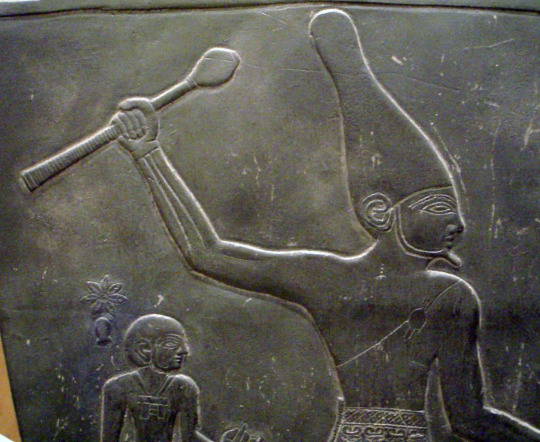
The pharaohs of Upper Egypt had a cooler crown, the “red crown,” or deshret. It had a nifty swoop at the back, and sometimes a little curlicue sticking up from it. Here’s a version from a New Kingdom painting:
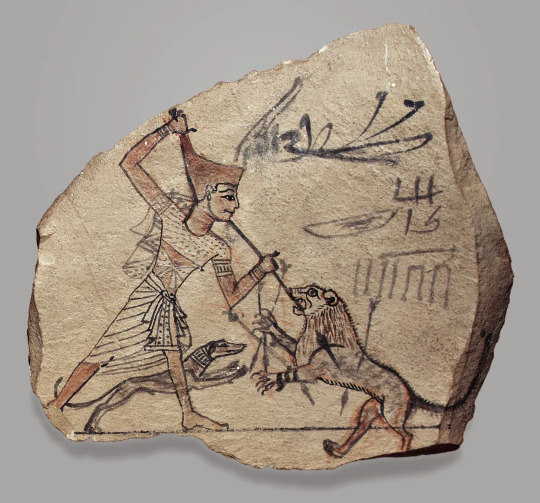
{Buy me a coffee} {WHF} {Medium} {Looking Through the Past}
More on Egyptian crowns, including why we've never found an actual Egyptian royal crown:
360 notes
·
View notes
Text
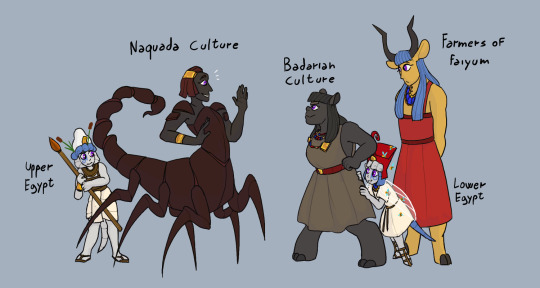
Just some general Designs of Pre-Dynastic Egypt Cultures
Farmers of Faiyum were people in Lower Egypt (Faiyum) , They were mostly Hunter-Gatherers but had approached agriculture (4500 BC) due to the discovery of baskets made from woven reeds. They possibly had interactions with the Levant. (southern mesopotamia) I've decide to give them traits of the God Hathor often depicted as a cow, symbolizing her maternal and celestial aspect! She was the symbolic mother of their earthly representatives, the pharaohs so yes , big cow mother :D Badarian Culture (4500-4000 BC) , were people mostly near El-Badari, mostly nomads but had also sculptures and art! !!!Correction : "The glazed steatite beads were not made locally. These all suggest that the Badarians were not an isolated tribe, but were in contact with the cultures on all sides of them. Nor were they nomadic, having pots of such size and fragility that would have been unsuitable for use by wanderers." They were more settled , they structures just didn't survive the flow of time... The lack of weapons tells us that they probably didn't didn't come froma warrior society.
They are also the Ancestors of the egyptians genetically! Gave them Taweret Characteristics ! (the protective goddess of childbirth and fertility.) A very cool viceo about Pre-Dynastic Egypt ! X Lastly the Naquada Culture (4000-3000 BC / 3900-3100 BC) they were mostly around the Upper Egypt Area , they are regarded as the founders of the old kingdom of Egypt. They Influenced the religion , colture and style of Ancient Egypt! I depicted them as a scorpion because of the legendary "King Scorpion". (Scorpion ||)
He was a powerful ruler in Upper Egypt that held power in Hierakonpolis then Thinis (not found city) Around 3200 BC
His son , Narmer /Menes (regarded as the same person) is seen as the son of this Scorpion king from what I read and heard , he is the one to unite Lower and Upper Egypt in 3150 BC !
I'm making Upper Egypt the child of the Naquada Culture , and Lower Egypt the child of the Badarian Culture, with like the Farmers of Faiyum being the general mom for both Upper and Lower Egypt! There is also an other Culture I need time to think on how to depict still that is the Merimde Culture , people that lived near the delta of the Nile to the West, I was thinking of making them a crocodile... maybe? I need to think it better! There is also many "city state" like cities , but to lower the amount of stuff to draw I am making general depictions of the main group of peoples I find! (may depict cities in case of very important cities like I did for Alexandria in the past)
I'll doodle some interactions between them because there is some very cool stuff but also some very sad things about the unification of Egypt ...
#countryhumans#countryhumans bronze age#countryhumans lower egypt#countryhumans upper egypt#countryhumans Faiyum#countryhumans badarian culture#countryhumans naquada culture
31 notes
·
View notes
Text
Part 3
Alfred had known, from the second his little boy Bruce had reappeared in the Manor's lobby, that he was no longer alive. At least, not entirely. When he held him, he was too cold; his eyes were too blue, almost glowing; he looked somehow both nineteen and eight years old. In the eleven years that he had been missing, Bruce had been changed irreparably.
It didn't help that he didn't know where he'd been.
But none of that mattered. All that mattered is that Bruce, after being gone for eleven years, was finally home.
There was much to be done, but all of that could wait until after Bruce had recovered a bit of himself. Hopefully, that was still possible.
The first week after arriving, he took to wandering the Manor and the grounds, refamiliarizing himself with his home. He did so quietly, nary saying anything without being spoken to first. And even then, it seemed as though he was pulling himself from a trance in order to respond.
Alfred was worried.
One day, at the end of the first week, he found Bruce sleeping on the bench at the cliff edge, the shadows of the trees draped over him like a blanket. They clung to him when Alfred picked him up. They clung to him even as they entered the Manor, dimming the area around them.
Even before they helped found Gotham, the Wayne Family was old. Thomas had told him, once upon a drunken evening, that his family had been practicing magic since the time of Pharaoh Narmer in Egypt.
An old family, Alfred had commented.
Older than I can comprehend, Thomas had toasted.
When they moved to the British Isles, the Wayne Family, who were already legends in their own right, were granted the nobility they'd always held. Along with the title and land, they were given a coat of arms. In umbris protegimus. In luce splendemus. In shadows, we protect. In light, we shine.
Magic was woven into the very essence of the Wayne Family, past from parent to child along with the title of Duke. A magic they brought with them to Gotham.
The very grounds that Wayne Manor stands on are enchanted to protect and be protected. The Wayne Family, whenever they come of age, are taught the spells of their family, taught to protect those who cannot protect themselves.
Bruce won't ever have that. Not from his parents. Not from Alfred.
It seems, however, that something has decided to give him his Family's inheritance.
As Alfred lays Bruce, who is both so small and so big, on his bed, he smiles. Maybe Martha and Thomas were still watching over their little boy.
Part 5
#City Spirit: Come Little Children#part 4#dcu#batman#alfred pennyworth#bruce wayne#bristol#gotham#new jersey#i used Translate.com for the Latin#is this how titles work? probably not but idc#this is my world and i can do what i want with it#world building
24 notes
·
View notes
Note
how does it feel to be the first person to piss on the poor
Ka or Sekhen, predecessor of the earliest well evidenced monarch of Egypt, Narmer, reigned in pre-unified Egypt around the 35th century BCE. Although he is obviously not the first hereditary autocrat to ever exist in the world, that name still is a handy pin to place in the timeline of the global history of monarchist governments, as one of the earliest reputed pharaohs in one of the oldest societies to leave written records.
So, buddy, while I appreciate the credit I'm at least 5300 years away from being the first.
38 notes
·
View notes
Note
Yami wouldn't find that sporting enough
I don't think Yami concerns himself about such things as being sporting, not when lives are on the line. After all, he's a Pharaoh... And no matter if he ruled between Akhenaten and Tutankhamon as in the original (and him actually being Smenkhkare would explain just why this Pharaoh was subjected to damnatio memoriae) or right before Narmer as per the international version, Pharaoh fought for keeps. And with the Egyptian account of the Battle of Khadesh flat-out saying Rameses II DID use magic to single-handedly hold the line long enough for the reserves to enter the fray...
Yami canonically started cheating during the TTRPG arc with Yami Bakura to prove that he knew YB was cheating and forced him to agree that they'd both stop. He could've been cheating the whole time or at least playing dirtier and it is only by his grace that he does not
16 notes
·
View notes
Text

"Hore" or what is known in Egyptology as "Horus"🇪🇬
- "Hoor" is the first Egyptian deity in the form of a falcon. His name is in the ancient Egyptian language "Hur", or: "Hoor", and in Greek "Horus", and with this name it was commonly mentioned in Egyptology references. He is one of the most important and oldest Egyptian deities ever, and since his appearance has been associated with the monarchy and the legitimacy of government, as the legitimate heir of his father "Osiris". Accordingly, the king was considered to be “Hoor” on earth, or as his representative on the throne of Egypt, an actual or symbolic representation. He is the ideal of all the kings of Egypt; As he avenged his father "Osiris" from his killer "Set" and he was just, and therefore they took the name "Horus the Living", which is one of the oldest royal titles in ancient Egypt, and his name was mentioned in ancient times associated with the god Hathor and the first scorpion king.
His name appeared on archaeological sources since the beginning of the dynasties, where Horus was depicted in this body on the prayer hall of King “Narmer” while he was restraining the captives from the era of the First Dynasty in Egypt while he held the heads of the defeated enemies of Egypt and presented them to the king, and even the Fourth Dynasty was the title of Pharaoh consisting only From the name of Horus, and during that dynasty the name "Golden Horus" also appeared, as a second title for the king.
The texts of “(Hijr Palermo)” refer to the kings of pre-dynastic times in Egypt that they were known as “Shamsio Hor”, meaning (followers of Hor), and the deity “Hoor” appeared in many images, and its theology expresses that it is one of the most Egyptian deities, depth and breadth in ancient Egyptian theology.
93 notes
·
View notes